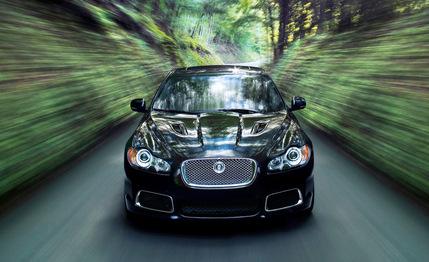
 Short Take Road Test
Short Take Road Test




Known lately for its sleepy, leaping cats, Jaguar has taken its fangs off the nightstand and stuck them back in. The sporty “R” designation gets pinned to the tail of the pretty and still-pretty-new $52,000 XF, the mid-size sedan below the big XJ. The result: 510 tech-infused horsepower and a price hike to $80,000. The driving sophistication is high, and some test numbers we managed to quickly extract during the XFR’s introduction are 10 degrees north of wow: 4.3 seconds to 60 mph, a quarter-mile pierced in 12.7 seconds at 115 mph. The M5 flinches.
Jaguar likes to talk about root icons such as the shark-finned Le Mans D-types and the blaze of XK120 headlights on the rain-swept Italian roads of the Mille Miglia. Ah, cracking good stuff—buried under a manure pile of more recent mediocrity. Arriving in late June, the 2010 XFR, like the aluminum-bodied XKR coupe, which also receives the supercharged, 5.0-liter direct-injection V-8, is a solid start at redemption.
Jaguar calls its smooth new roar maker the AJ-V8 R Gen III. The head bolts and valve tappets of the 5.0 are all that carry over from the previous 4.2-liter (which remains the XF’s base U.S. engine; a naturally aspirated, 385-hp 5.0-liter is in the middle model; the supercharged 4.2 is gone). The more compact aluminum block and heads are new, as is the eerily whine-free Eaton Gen 6 supercharger also found in the Corvette ZR1. The injector takes the spark plug’s usual position at top center, spraying down into a cupped piston that partially reflects the charge back toward the plug, just to the injector’s side. Minimized emissions and better volumetric efficiency—which means power—are the motivation, says Jag.
Downstream, Jaguar redesigned the steel rear subframe and spread wider the differential mounts in anticipation of 461 pound-feet of torque. A name-brand transmission favored by BMW is locked and loaded. In sport mode or under manual paddle control, the ZF six-speed ticks off nearly instant upshifts with barely a stutter.
Cementing the traction is an electronic differential that shuttles between open and full lock by varying electric motor torque on a ball-ramp assembly that squeezes clutch plates. Besides the big muscle, extra-sticky launch traction gets the credit for the XFR’s blazing quarter-miles.
The spring rates stiffen by a third, and with Bilstein electronically varying shocks and larger anti-roll bars, the body is locked in rigid horizontalness through the switchbacks. Does Jaguar suddenly best BMW’s best?
With its 20-inch wheels, the XFR is a hot number, its squarer jaw and extra mesh-screened ducts setting it apart. The progressive throttle tune is a triumph, and the grip from fat, Y-rated Dunlop SportMaxx tires makes it reliable. However, old thinking remains in the insulated steering and a nervous stability control. An intermediate “Trac DSC” mode allows more wiggle and screech, but it cuts in early and takes too long to butt out again. Drivers can shut it off, but any safety net goes with it.
M5 owners blog about such stuff. Do Jaguar buyers care? Jaguar needs the XFR to be unimpeachable—it’s tantalizingly close—if it hopes to leap to the next page.